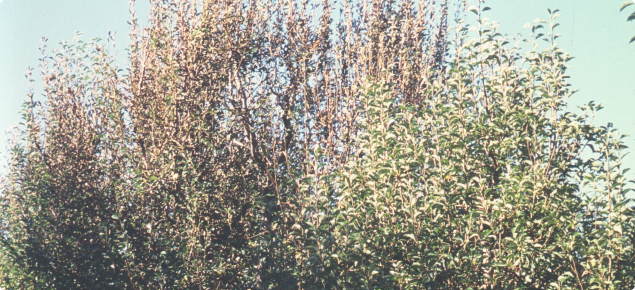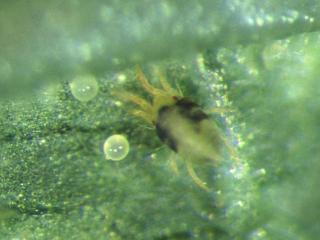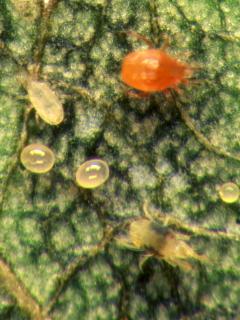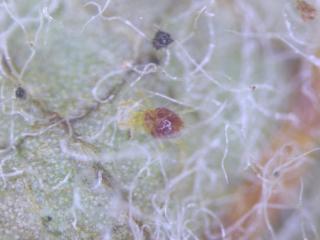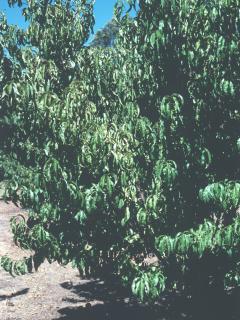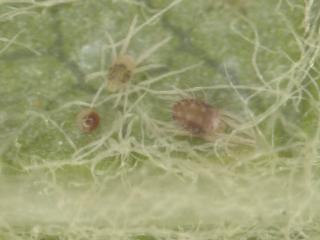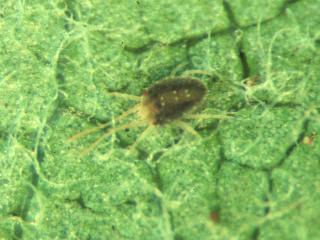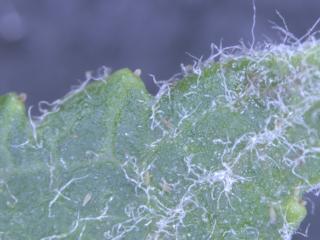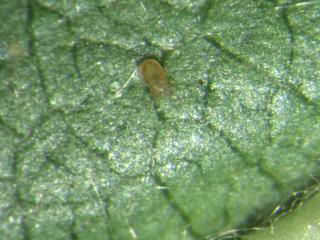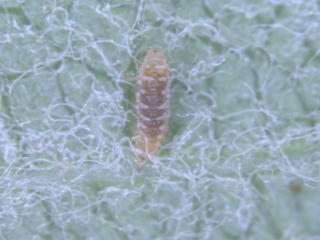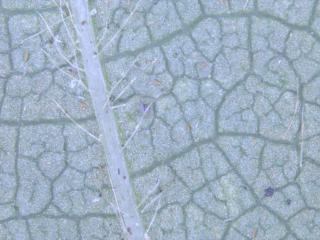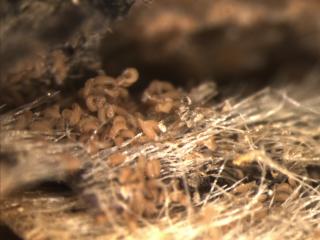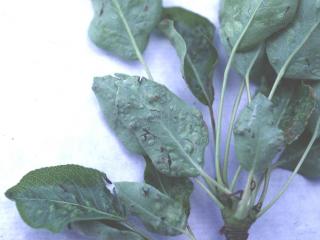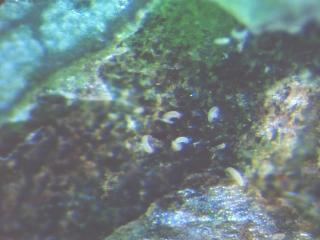Registered miticides
There are a number of miticides registered for use in Western Australian deciduous truit tree orchards, to control:
- Two-spotted mite
- European red mite
- Bryobia mite
- Pearleaf blister mite
A guide to these registered miticites is available for download on the right hand side of this page.
To spray or not to spray your pome- or summer- fruit trees for mites?
In Western Australian deciduous fruit tree orchards, natural control agents can help to reduce or eliminate the need for miticides to control pest mites. The principal natural enemies of pest mites include predatory mites, stethorus beetles, predatory thrips, and lacewing and fly larvae.
Because seasonal conditions vary, the decision on whether and when to use miticides can be gauged through regular monitoring — for both pest mites and their natural enemies. Guidelines for monitoring and action levels for pests and their natural enemies are included here and also in the list of references. To identify pest and beneficial predatory mites and other natural enemies, consult the references listed below or contact a specialist.
The exception to the advice on monitoring is where abamectin is used early on apples for control of two-spotted mite and European red mite. See below for special guidelines on this.
Two-spotted mite
Deciding when to treat
For control of two-spotted mite (Tetranychus urticae) in apples, abamectin can be applied two to six weeks after petal fall to ensure the miticide penetrates the leaf, forming a reservoir of active ingredient within it. For best results apply abamectin at the earlier timing.
For all other miticides and abamectin on pears, monitor for two-spotted mite and spray when the action threshholds have been reached (see below).
To monitor for mites, select blocks based on susceptible varieties. In each block, examine a 25 to 50 leaf sample, collected as one or two leaves from each of 25 trees, for example on a five by five grid. Take samples weekly from late November. Sample two weeks after spraying, then weekly or fortnightly depending on temperature - weekly in hot weather.
Suggested action threshholds
If natural enemies, especially predatory mites, are seen frequently while monitoring for pest mites and temperatures are not high, miticide application may be delayed until the role of the natural control agents becomes clear. Action threshholds suggested below assume that natural control agents are either absent or present at very low levels..
Apples and summerfruit
For the ovicides (egg killers) clofentezine (for example Apollo) and hexythiazox (for example Calibre, Hexythiazox and Zilch) used alone, apply at around 10% leaf infestation.
For ovicides mixed with miticides that control motile stages (mobile stages after hatching) as well as for miticide where ovicides are not included, apply at 30 to 40% leaf infestation.
At these action threshholds, the trees will appear to be completely healthy and uninfested. The threshholds are recommended because with the onset of high summer temperatures, reproduction is rapid and mite outbreaks are difficult to control. Monitoring allows preventative action to occur as and when needed.
Pears
At low densities of two-spotted mites, pears suffer leaf scorch. Thus, the threshhold for applying miticides is lower than for apples. For all miticides, apply at around 10% leaf infestation. Ovicides may be mixed with miticides.
Resistance management
Apply miticides when leaf monitoring indicates the need to spray. An exception is when using abamectin early on apples, but this is acceptable in adopting a resistance management strategy by alternating miticides with a different mode of action.
If using abamectin early on apples, consider applying the miticide to half the area only during a season. In the following season, use miticides from other chemical groups for this area. The other half could be treated with miticides in the same way, but in the alternate season.
Rotate the use of miticides based on the chemical group each belongs to — refer to the table below. Rotate miticides between chemical groupings, both within and between seasons.
After about six seasons of consecutive applications of the ovicides clofentezine (for example Apollo) and hexythiazox (for example Calibre, Hexythiazox and Zilch), experience has shown that miticide resistance has made them virtually ineffective. Moreover the mites will not become susceptible again even if their use is discontinued - the resistant 'strain' of mite seems to have some advantage over the previously susceptible mites such that this new strain dominates.
Because fenbutatin oxide (for example Torque and Vendex) and propargite (for example Betamite and Omite) do not control mite eggs, two consecutive sprays seven to ten days apart are recommended for moderate to heavy infestations. Fenbutatin oxide is more effective when applied in hotter weather. If further spraying is required, use a miticide from a different chemical group.
If season-long protection from mites is achieved after abamectin only, and monitoring next season indicates a need to control mites, apply a miticide from a different chemical group first.
European red mite
European red mite (Panonychus ulmi) was first detected in Western Australian orchards during the 2004/05 season in the Manjimup/Pemberton region. Since then, it has been recorded from all fruit growing regions in WA. It is mainly a pest of apples, but can also be a pest of summerfruit (stone fruit) crops, especially plums. European red mite is similar in shape to two-spotted mite, but is red and has more prominent spines on its back. Adult male mites are pale yellow and have longer legs than females. Like bryobia mite it has red eggs, but differs in that a spine protrudes from the apex of eggs.
Deciding when to treat
Overwintering European red mite eggs are susceptible to oil sprays near hatching. An appropriate time to apply a summer oil is just after full bloom to early petal fall. The decision to spray should be based on the extent of the leaf infestation near the end of the previous season, and the presence of large numbers of overwintering eggs.
To decide whether other miticides should be applied later in the season, follow the two-spotted mite recommendations including applying abamectin early and leaf monitoring.
Suggested action thresholds
Leaf scorch in pears has not been reported for European red mite. As a result, the action thresholds recommended for infestations are the same for all deciduous fruit. European red mite feeding causes mottling on the upper surface of leaves. During early infestation there are no symptoms on the lower surfaces, but with high infestations, leaf bronzing and leaf fall may occur.
For the ovicides clofentezine (for example Apollo) and hexythiazox (for example Calibre, Hexythiazox and Zilch), alone, apply at around 10% leaf infestation.
For ovicides mixed with miticides that control motile stages (mobile stages after hatching) as well as for miticide where ovicides are not included, apply at 30 to 40% leaf infestation.
Resistance management
As is the case for two-spotted mite, European red mite can develop miticide resistance. Adopt the same principles of resistance management as described for two-spotted mite.
Bryobia mite
Bryobia mite (Bryobia rubrioculus) is much less common than two-spotted mite and has fewer natural enemies. Bryobia mite can be the main mite pest in low pesticide use orchards, with other mite species under control by predators.
Like European red mite, bryobia mite overwinters in the egg stage and eggs are red. Eggs do not have the apical stalks that occur on eggs of European red mite.
Monitoring is required to confirm the presence and abundance of bryobia mite. Miticides should be applied at similar timing and densities as for European red mite. Some insecticides that control foliage pests of deciduous fruit trees also control bryobia mite..
Apple rust mite
Apple rust mite (Aculus schlechtendali) is an occasional pest of apples. Mites feed on leaves causing them to turn grey, reducing their photosynthetic potential and heavy populations may result of scarring of the skin of apples. Nymphs are pale and adults are light brown and torpedo shaped. This mite is in the eriophyid group, with adults being very small at approx. 0.2mm long. Leaves require microscopic examination to confirm whether apple rust mite is the cause of leaf discolouration. Such discolouration is the best indicator of the presence of this pest mite. Usually the mites are controlled by a predatory mite and spraying is not required. These predatory mites have been identified to belong to the Amblyseius bellinus group. This species of predatory mite has not been recorded as a predator of either two-spotted mite or European red mite in WA apple orchards. Other predators such as larvae of a species of fly also help reduce the abundance of apple rust mite.
Plum rust mite
Plum rust mite (Aculus fockeui), previously known as peach silver mite, is an occasional pest of peach and nectarine trees. The mites are so small (about one-sixth of a millimetre long), that the first sign that they are present is when leaves turn grey as a result of their feeding. A microscope is needed to confirm their presence.
Whether control measures are required depends on the level of leaf infestation, which is indicated by leaves turning grey or appear as if covered in dust. If a high proportion of trees are infested and most of the foliage on each tree is turning grey, a miticide is required. Unlike other species of pest mites, plum rust mite does not seem to be a pest each season. This lack of consistent pest occurrence suggests predators are unlikely to help control them. Also, this may explain why predatory mites have not yet been detected when infestations of plum rust mite occur.
Miticides containing the active ingredient milbemectin control plum rust mite. Other registered miticides containing etoxazole and fenbutatin oxide have been tested and found effective against this eriophyid group of mites, but they were not specifically examined for their effectiveness against plum rust mite..
Plum leaf mite
Plum leaf mite (Phyllocoptes abaenus) has been recorded on one occasion only, damaging the growing tips on plums trees in WA. The margins of emerging new leaves were bronzed and the growing tip was smaller and slightly distorted compared with uninfested growing tips. The mites are small - similar to plum rust mite.
The occurrence of this mite is so sporadic that it is regarded as a minor pest.
Pearleaf blister mite
Pearleaf blister mite (Eriophyes pyri) is an occasional pest of pear trees. The mites are so small (about one-fifth of a millimetre long), that the first sign they are present is when leaves develop characteristic yellow/green blisters on the upper leaf surface. These blisters turn brown and black as the affected leaf tissue dies. In heavy infestations, fruit may be infested and become scarred or misshapen. The blisters on leaves appear because the mites feed within a cavity in the leaf. The cavity has a hole on the lower leaf surface through which adults can move to set up other colonies. A microscope is needed to confirm that they are the cause. Adult mites are pale and torpedo shaped with two pairs of legs at the head end. They have multiple generations through the growing season before entering buds in which they overwinter.
Unlike other species of pest mites, the occurrence of pearleaf blister mite is very sporadic. Consequently, predators are unlikely to help control them. The predatory mite Metaseiulus occidentalis which occurs in WA orchards, reportedly feeds on pearleaf bister mite. Infestations may build within and between seasons. If a high proportion of trees show signs of infestation, further damage may be prevented with the application of miticide, as listed in the table below or as suggested above for plum rust mite control.
Further reading
Bower CC & Thwaite WG 1995, The mite management manual — a practical guide to integrated mite control in apples. NSW Industry and Investment (DPI).
Hetherington S 2005, Integrated pest and disease management for Australian summerfruit. NSW Industry and Investment (DPI) and Summerfruit Australia.
Hetherington S 2009, Integrated pest management for Australian apples and pears. NSW Industry and Investment (DPI) and Apple and Pear Australia Limited.
Malipatil MB, Williams DG & Semeraro L 2009, Pests of pome and stone fruit and their predators and parasitoids — a pocket guide. Department of Primary Industries, Victoria.


